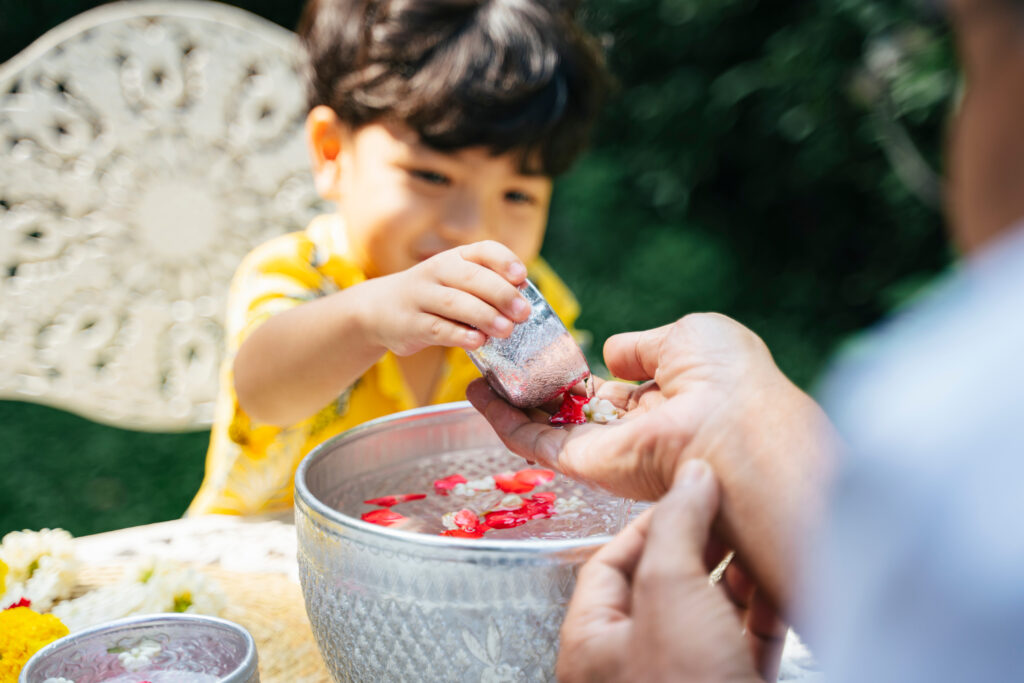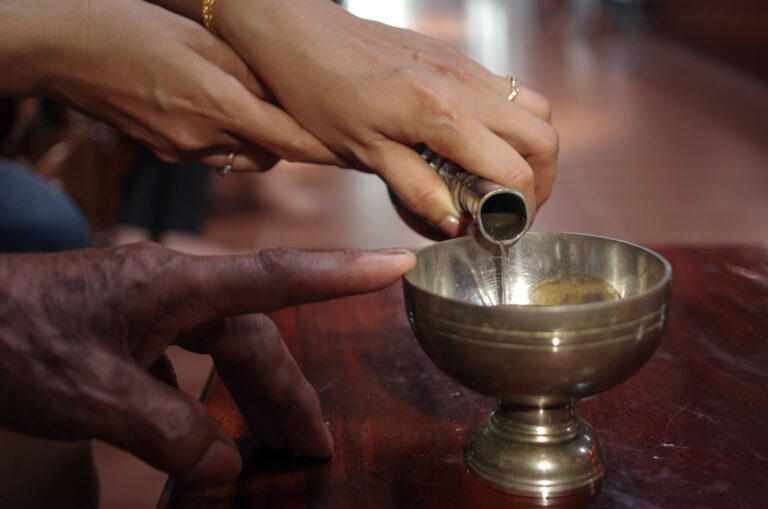How Songkran is celebrated
Thailand’s Water Dance of Renewal, Family, and Timeless Tradition
Day of Purification
Songkran aligns with the natural rhythms of the seasons, reminding people of the cyclical nature of time and the constant process of change and renewal. The festival promotes a sense of harmony with nature, encouraging people to live in balance with the environment.
Songkran is therefore an allegory of human’s relationship with nature. It uses symbols to represent the seasonal rhythm of renewal and transformation, as well as reminding us of the healing power of nature.


More than just a water fight, Songkran is a time for families to gather, pay respects to elders, and visit temples to seek blessings for the year ahead.
The act of water splashing takes on a deeper meaning. Buddhism and Hinduism both emphasizes spiritual purification. A splash of water therefore symbolizes the washing away of past sins and impurities, both physical and spiritual, preparing the soul for the new year.

Pouring water over Buddha statues is a common practice to show respect and pay homage to compassion, love, and the desire to help all beings. It is believed to wash away negative energies and bring blessings.

Pouring water over Buddha statues is a common practice to show respect and pay homage to compassion, love, and the desire to help all beings. It is believed to wash away negative energies and bring blessings.

Day of Reunion and Remembrance
Songkran is also a celebration of family, respect for elders, and the continuity of cultural traditions. It’s a time for families and friends to come together, strengthen their bonds.
Families often participate in various Songkran activities together, such as visiting temples, making merit, preparing traditional food, and of course, engaging in water fights.
But before the water fight can begin, merit making activities (tham bun) must be carried out. Deeply rooted in Buddhist beliefs, it encompasses a wide range of good deeds and actions aimed at accumulating positive karma
But before the water fight can begin, merit making activities (tham bun) must be carried out. Deeply rooted in Buddhist beliefs, it encompasses a wide range of good deeds and actions aimed at accumulating positive karma
Freeing captured animals, such as birds or fish, is also believed to be an act of compassion and to bring good luck.


Building sand pagodas is another important tradition, representing the creation of a sacred space for meditation and reflection.

Most importantly, Songkran is the day to remember love ones. Here, water plays another significant role. The ritual of pouring of water (Kruat Naam) symbolizes the dedication of merit, a libation to those who have passed away and to ask for forgiveness from whom we may have offended.
Day of Festivities
The playful water fights are a central part of Songkran festivities. It’s a time for people to let loose, have fun, and enjoy the company of friends and family. Songkran is a vibrant and joyful celebration, with music, dancing, parades, and delicious food. The atmosphere is infectious, spreading happiness and positive energy.

A Video Clip “100 Years of Songkran Fashion”
Source : Wake Studio
Music and Dance are important elements of the Songkran tradition. You’ll hear traditional Thai music, contemporary pop, and even electronic dance music blasting from speakers and stages throughout the festival. This lively music adds to the excitement and creates a fun, party-like atmosphere.
Day of the Goddess of Fortune
One of the most anticipated activity during Songkran festival is the announcement of Nang Songkran or the seven daughters of Brahma who plays a vital role in shaping the perception of the year’s fortune in Thai tradition.
Her association with the New Year, her influence over events, and her connection to divine power make her a significant figure in Songkran celebrations and beliefs. People look to her characteristics and the interpretations of astrologers to gain insights into the coming year including weather patterns, agricultural yields, and even political and social trends.
1955
1958
1960
1968
1979
1982
1988
1992
1994
2000
2003
One of the most anticipated activity during Songkran festival is the announcement of Nang Songkran or the seven daughters of Brahma who plays a vital role in shaping the perception of the year’s fortune in Thai tradition.
Her association with the New Year, her influence over events, and her connection to divine power make her a significant figure in Songkran celebrations and beliefs. People look to her characteristics and the interpretations of astrologers to gain insights into the coming year including weather patterns, agricultural yields, and even political and social trends.
